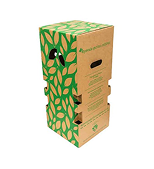- Home
- Medicinal Plants
- Chamaecostus cuspidatus/Insulin Plant -...
Chamaecostus cuspidatus/Insulin Plant - Medicinal Plant











Chamaecostus cuspidatus/Insulin Plant - Medicinal Plant




Damaged or lifeless? We’ll replace it for free. Learn more

Double layered custom boxes to protect plants during shipping.

Air vents for proper air-flow

To preserve plant freshness during transit

Details steps of how to grow and maintain your plant
The insulin plant is botanically known as Chamaecostus cuspidatus or Costus igneus from the Costaceae family. It is also known as Fiery Costus or Spiral Flag Insulin plant is a medicinal plant and capable of having Magic Cure for Diabetes. It is an easily grown medicinal plant and is best for planting throughout the year. It is widely grown in gardens as an ornamental plant in Indian Garden and also grows wildly in many places. It has large fleshy-looking leaves. The leaves are spirally arranged around the stem, forming attractive, arching clumps arising from underground rootstocks. The maximum height of these plants is about 2-3 feet. It also flowers during the warm months. And they appear to be cone-like heads at the tips of branches.
Medicinal Character
- The Insulin plant is one such traditional plant that is getting global acceptance nowadays and is now widely used as an ayurvedic medicinal herb.
- Consumption of the leaves is believed to lower blood glucose levels, and diabetics who consumed the leaves of this plant are said to have a fall in their blood glucose levels.
- The leaves of the Insulin Plant contain corosolic acid which helps to generate insulin thereby treating diabetes.
- It has been proven to be antioxidant, antimicrobial, and anti-cancerous.
- In Siddha medicine, used for diabetes; leaves are chewed twice daily, or dried leaf powder is taken 1/2 to 1 gram twice daily.
- it is also helpful for patients with hypertension, asthma, and kidney and liver problem.
Care Tips
- You can grow it directly in the medium to large size pot or directly in the ground.
- It prefers to grow in humid areas and low sunlight areas wherever morning or evening sunlight is available.
- Provide support to keep plants safe, especially during the heavy wind.
- Add organic manure once in 2 months.
INSIDE THE BOX
| S.No. | PRODUCT NAME | DIMENSION |
| 1. | Insulin Plant | 1-2 Feet Height |
| 2. | Growing Pot (Black color) | 6 Inch |
**above specifications are for indicative purpose only, actual dimensions may slightly vary.
INITIAL CARE FOR 10-15 DAYS JUST AFTER RECEIVING YOUR PLANT
- Remove the Packaging Materials carefully.
- Press the soil in the pot & add additional soil(garden mix) if necessary.
- Maintain moisture in the pot, Do not overwater it may kill your plant, so make sure that the soil should be dry between watering.
- Make sure that plants get enough morning direct bright light(2-3hrs) for 10-15 days & do not go for immediate transplanting (minimum 1 month)
- After 1 month you can transplant it into a slightly bigger pot than the present pot or directly in the ground.
- Just prune if any branch of the plant is get damaged in transits. New leaves will come definitely.
Selected plant of 8-10 inches
Planted into a 5-inch pot
With healthy, moisture-retaining soil
A care instruction sheet for maintenance guide

Get in touch for best pricing on bulk orders and landscaping projects.
 WhatsApp us
WhatsApp us

Call on 9177805454 (Mon-Sat, 9 AM-6 PM) or WhatsApp us – we’re here to help.
About Exotic Flora
At Exotic Flora, we’re passionate about bridging the gap in bringing plants to everyone. With over 500+ varieties across 7 plant categories, from exotic finds to everyday greens, we bring the entire range to you.
Our plants, sourced from all parts of India are nurtured at Kadiyam, in our 25 acres in-house nursery by a team of expert horticulturists. Once they are ready we ship all our plant varieties across India.
Our services go beyond safe delivery of plants. A dedicated support team is there to help you with any maintenance queries you may have.
At Exotic Flora we always believe in going that extra mile, because everyone should have the plants they love.
Every plant has different plant parts to use as a medicinal plant it may be in its leaves, roots, stems, flowers or other parts of the plant. For full details look at the descriptions of individual plants.
Citronella grass, Lemon grass, Rosemary, Marigold, Mint Tulasi etc
Some plants need indirect bright light & others need direct bright light and some can grow in both direct and indirect sunlight. So please look at the description of each individual plants.
The soil should be well drained, fertile and rich in organic content. A mixture of garden soil, cocopeat, compost will give the best results for your plants.
Remember overwater can kill your plant(make sure that your pot should have drainage hole). Water when the topsoil(2-3 inch) feels dry to touch. In general moderate watering(in every 3-4 days)
Regular pruning of diseased and damaged parts of the plants. Regular watering, proper ventilation & sunlight, organic manure & fertilizers application.
In general you can grrow in indirect bright light conditions like basil, rosemary, mint, Centella asiatica, Maghai paan / betel leaf.
Tulsi has been used for thousands of years in Ayurveda for its diverse healing properties apart from devotional purpose.
No, both are different plants, Tulsi which is commonly known as holy basil, where as mint tulsi is closely related to holy basil & doesn't have devotional property.
Stevia is a sugar substitute made from the leaves of the stevia plant. It's about 100 to 300 times sweeter than table sugar, but it has no carbohydrates, calories, or artificial ingredients.
Costus igneus, commonly known as insulin plant in India. Consumption of the leaves are believed to lower blood glucose levels, and diabetics.
Packing is so good.They put the water ball in soil so that plant remains healthy.Full marks to exotic floral.I got fresh plant after 5 days in transport.I recommende every one buy from exoticflors
ALL THE PLANTS ARE GROWING BEAUTIFULLY HAVING NEW LEAVES. PLEASE LET ME KNOW HOW THE INSULIN PLANT LEAVES TO BE EATEN?